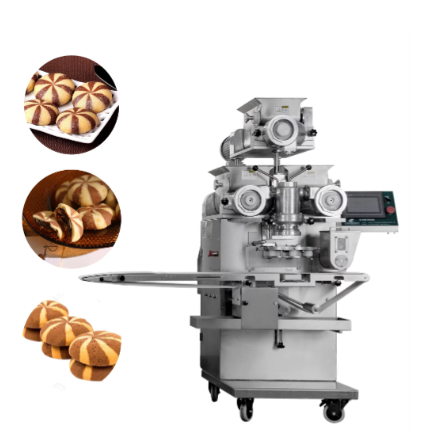Revolutionizing Middle Eastern Cuisine with Modern Technology
Traditional Middle Eastern kitchens are embracing a remarkable transformation with the introduction of the kubba machine, an innovative appliance that's changing how this beloved dish is prepared. This groundbreaking technology preserves the authentic taste of handmade kubba while dramatically reducing preparation time. For restaurants, catering services, and food manufacturers, this advancement represents a perfect blend of tradition and efficiency.
The kubba machine has become increasingly popular among professional chefs and food service providers who need to maintain consistent quality while meeting growing customer demand. This sophisticated equipment ensures that each kubba piece maintains the perfect ratio of outer shell to filling, delivering the authentic taste that customers expect while significantly streamlining the production process.

Understanding the Kubba Machine Technology
Advanced Mechanical Components
The kubba machine features state-of-the-art engineering designed specifically for creating perfectly formed kubba. The main components include a specialized mixing chamber, precise portion control mechanisms, and automated forming systems. These elements work in harmony to process both the outer shell mixture and the filling, ensuring consistent results every time.
The machine's sophisticated design incorporates food-grade materials and easy-to-clean surfaces, making it both safe for food production and practical for daily use. The automated systems can handle various grain types and meat fillings, adapting to different regional recipes and preferences.
Production Capacity and Efficiency
When it comes to production volume, a kubba machine demonstrates impressive capabilities. A single unit can produce hundreds of perfectly formed kubba pieces per hour, equivalent to the output of several skilled workers. This increased efficiency doesn't just save time – it also reduces labor costs and ensures consistent quality across large batches.
Modern kubba machines are equipped with adjustable settings that allow operators to control the size, thickness, and filling ratio of each piece. This versatility ensures that businesses can cater to different customer preferences while maintaining high production standards.
Economic Advantages for Food Businesses
Cost Reduction and ROI
Investing in a kubba machine represents a strategic decision that can significantly impact a business's bottom line. The initial investment is quickly offset by reduced labor costs, increased production capacity, and minimized waste. Traditional hand-rolling methods require skilled workers and considerable time investment, while a kubba machine can operate continuously with minimal supervision.
Business owners typically see a return on investment within months, especially in high-volume operations. The machine's precision in portioning ingredients also helps control food costs and reduce waste, contributing to improved profit margins.
Scaling Production Capabilities
For growing businesses, the kubba machine offers unprecedented scaling potential. Whether serving a local market or expanding to regional distribution, the equipment can adapt to increasing demand without sacrificing quality. This scalability is particularly valuable for catering services and food manufacturers looking to expand their market presence.
The consistent output quality also makes it easier to maintain product standards across multiple locations or production facilities, ensuring customers receive the same high-quality product regardless of where it's prepared.
Quality Control and Consistency Benefits
Standardization of Product
One of the most significant advantages of using a kubba machine is the ability to achieve perfect consistency in every batch. Each piece emerges with identical size, shape, and filling ratio, meeting exact specifications every time. This standardization is crucial for businesses that pride themselves on delivering reliable quality to their customers.
The machine's precise control systems ensure that the outer shell maintains the ideal thickness and texture, while the filling is distributed evenly throughout each piece. This level of consistency is particularly important for restaurants and food service providers who need to maintain strict portion control and presentation standards.
Food Safety and Hygiene
Modern kubba machines are designed with food safety as a priority. The automated process minimizes human contact with ingredients, reducing the risk of contamination. Stainless steel components and easy-to-clean surfaces ensure that proper sanitation can be maintained throughout production.
The equipment often includes built-in temperature control features that help maintain safe food handling conditions, particularly important when working with meat-based fillings. These safety features help businesses comply with health regulations while ensuring product quality.
Operational Insights and Best Practices
Maintenance Requirements
To ensure optimal performance and longevity of a kubba machine, regular maintenance is essential. This includes daily cleaning procedures, periodic inspections of mechanical components, and scheduled professional servicing. Proper maintenance not only extends the equipment's lifespan but also ensures consistent product quality.
Training staff in proper machine operation and maintenance procedures is crucial for maximizing the benefits of the investment. Many manufacturers offer comprehensive training programs and ongoing support to help businesses make the most of their equipment.
Production Planning Strategies
Effective use of a kubba machine requires careful production planning. This includes scheduling batch sizes, managing ingredient preparation, and coordinating with storage or service requirements. The machine's capabilities should be matched with business demand to optimize efficiency and minimize waste.
Understanding peak production times and seasonal demands helps in developing efficient production schedules that maximize the machine's potential while meeting customer needs.
Frequently Asked Questions
How long does it take to learn to operate a kubba machine?
Most operators can become proficient with basic machine operations within a few days of training. However, mastering all features and achieving maximum efficiency typically takes about two weeks of regular use under proper supervision.
What types of kubba can be produced with the machine?
Modern kubba machines are versatile and can produce various styles including Iraqi, Lebanese, and Syrian kubba varieties. The machines can be adjusted to work with different grain types and filling mixtures, accommodating regional preferences and recipes.
How does machine-made kubba compare to handmade in terms of taste?
When properly configured and operated, kubba machines produce products that are virtually indistinguishable from handmade versions. The key is using quality ingredients and maintaining proper machine settings. Many customers actually prefer the consistency of machine-made kubba while appreciating the traditional taste and texture.






